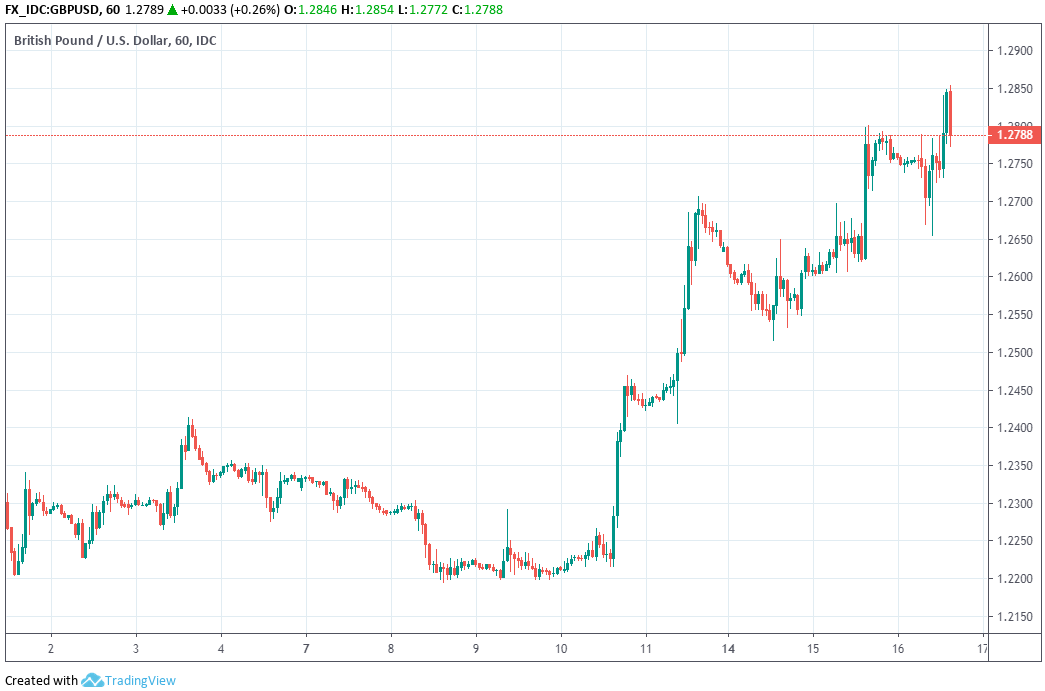Pound-Dollar Rate Extends Rally after U.S. Retail Sales Disappointment but Risks Becoming Vulnerable
- Written by: James Skinner
-

Image © Adobe Images
- GBP/USD extends gains after U.S. retail sales disappointment.
- Sales fall in September after consumers leave cards in wallets.
- Softer spending growth and slower hiring mean more Fed cuts.
- Fed to weigh on USD if rate cuts become all out easing cycle.
- GBP benefits from Brexit opitmism but is becoming vulnerable.
The Pound-Dollar rate extended its nascent rally Wednesday after official figures revealed a surprise fall in U.S. retail sales in September, the latest sign of a slowdown in the world's largest economy, but the exchange rate is increasingly vulnerable to a correction ahead of the weekend.
Retail sales fell by 0.3% last month, according to Census Burea data, when markets had been looking for a 0.3% increase. Core retail sales, which remove large-ticket car sales from the numbers because of their distorting impact on underlying trends, fell 0.1% last month when the consensus among economists had favoured a 0.2% gain.
Disappointment was tempered by an upward revision to August's 0.4% increase, which has been restated as 0.6%, while the more important core number was revised up to 0.2% after having originally been reported as 0%. Falling vehicle sales were the main driver of September's decline.
"That comes off the back of strength earlier in the quarter, with the three-month average annualized pace of sales still at a healthy 6.8%, only a slight deceleration from Q2. Given slower hiring, we expect consumption to slow ahead while remaining reasonably healthy. The disappointing headline should be negative for the USD," says Katherine Judge at CIBC Capital Markets.

Above: Pound-to-Dollar rate shown at hourly intervals.
Markets care about the data because it reflects rising and falling demand in the economy, which is key to the outlook for the consumer price pressures that central banks are attempting to manipulate when they tinker with interest rates. Changes in rates are normally only made in response to inflation, which is sensitive to growth, but impact currencies because of the push and pull influence they have over capital flows. Those flows tend to move in the direction of the most advantageous or improving returns.
The Federal Reserve (Fed) has cut its interest rate twice already this year in an attempt to protect the economy against a global economic downturn that it fears will eventually bitethe U.S. But the bank has continued to bill its cuts as a 'mid-cycle' adjustment of policy settings rather than the beginning of an all-out 'easing cycle'. The latter would inevitably amount to policymakers declaring the post-crisis recovery, which is the longest expansion in U.S. history, to be over.
"Amid the ongoing trade war and worries about a potential recession, the strength of consumer spending has been a needed counterweight. Today’s 0.3% decline in September retail sales is the first crack in the foundation," says Tim Quinlan at Wells Fargo. "This report is the first hard data to indicate cracks in one of the key pillars of the economy that, so far, had been holding up well."
The Dollar outlook depends greatly on what the Fed does next, but Wednesday's retail sales figures could mean the bank is now more likely to cut rates again on October 30. Pricing in the overnight-index-swap market implied on Wednesday, that by October 30 the top end of the Fed funds rate range would sit at just 1.78%. That's only three basis points above the level that would prevail if the bank announced a typical 25 basis point cut at the end of this month.
Above: Dollar Index shown at daily intervals and annotated for recent events.
Investors had, less than a month ago, seen the Fed as most likely to wait until at least December before cutting again but they now appear all but convinced a further easing of policy is in prospect this month. Failure to indulge the market with an October cut could lift the Dollar, while delivering it might tempt the market into betting that an all out 'easing cycle' is afoot. The latter might then give way to a more protracted period of Dollar weakness.
"Softer-than-expected US retail sales will reinforce the case for further stimulus. Coupled with weak inflation expectations and a deteriorating business backdrop we expect October, December and January rate cuts," says James Knightley, chief international economist at ING.
The greenback is still up against all but three of its nine major rivals for 2019 while the Dollar index, which measures the U.S. currency relative to a number of its most frequently traded rivals, is up 2.2% for the year. Whether many of those moves reverse before year-end remains to be seen but, for Pound Sterling at least, the tide has already turned. The British currency is now up 0.79% for the year after having been down more than 5% just weeks ago.
Markets are increasingly optimistic that a deal securing the UK's orderly exit from the EU can be reached this week, ahead of the Saturday 19 'Benn Act' deadline for Prime Minister Boris Johnson to request a third Brexit delay if such an accord has not been approved by both chambers of the UK parliament.
Above: Pound-to-Dollar rate shown at daily intervals.
"Our (equally-weighted) G9 FX Index has seen the USD rally roughly 3% since July. Barring GBP, the whole G10 complex has weakened," says Mark McCormick, head of FX strategy at TD Securities. "The trade wars have benefited mean-reversion over trend-following strategies. If we look across the G10, the cheapest currencies are AUD, NZD, NOK, and SEK. GBP trades 2.8% [above fair value], underscoring how touchy markets are on positive Brexit headlines. Barring GBP, these numbers suggest the USD screens about 1.4% rich to the rest, and yet EUR and CAD are trading mostly where they should."
There's almost no chance of any deal being approved by parliament before Saturday even if one is agreed but Pound Sterling has been heartened by frequent claims of progress from Westminster and Brussels because if there is even the faintest hope of an accord being strcuk then it could make the Prime Minister less resolved to pursue a 'no deal' Brexit on October 31.
Johnson has staked his premiership on a "do or die" pledge to get the UK out of the EU on October 31 whatever the negotiating weather on that day. Some MPs broke with the constitution and succesfully hijacked the parliamentary agenda in September, to pass legislation preventing the PM from doing that. But Johnson still insists the UK will leave on October 31 and some analysts are suggesting the Pound may already have gone far enough in its rally for now.
"There are perhaps two more surges higher possible here in sterling – first a minor one if the uncertainty around the DUP is swept away and the two sides come to terms and then the second one if the UK Parliament has the votes to approve Johnson’s deal. But the options market is already skewed to pricing more upside volatility," says John Hardy, chief FX strategist at Saxo Bank.
Time to move your money? Get 3-5% more currency than your bank would offer by using the services of a specialist foreign exchange specialist. A payments provider can deliver you an exchange rate closer to the real market rate than your bank would, thereby saving you substantial quantities of currency. Find out more here. * Advertisement
